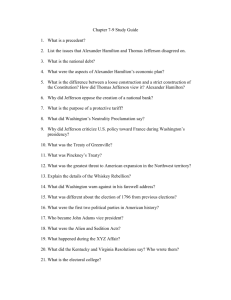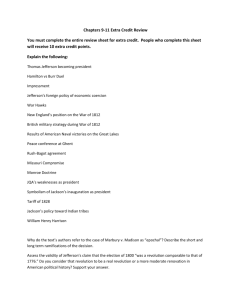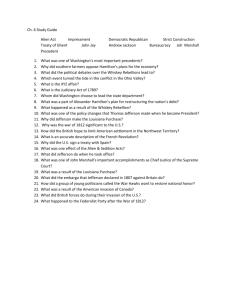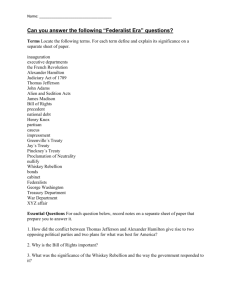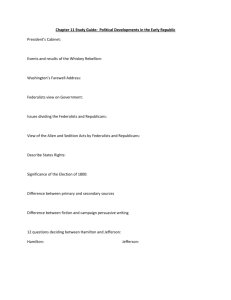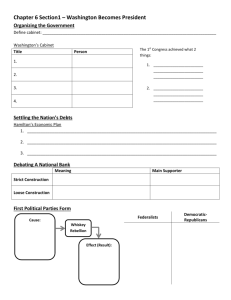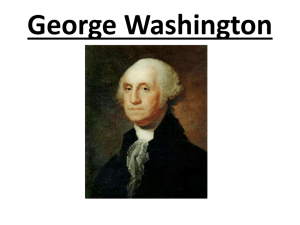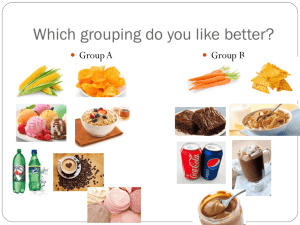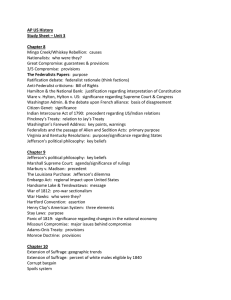Chapter 9 Study Guide Was the American truly a “revolution
advertisement
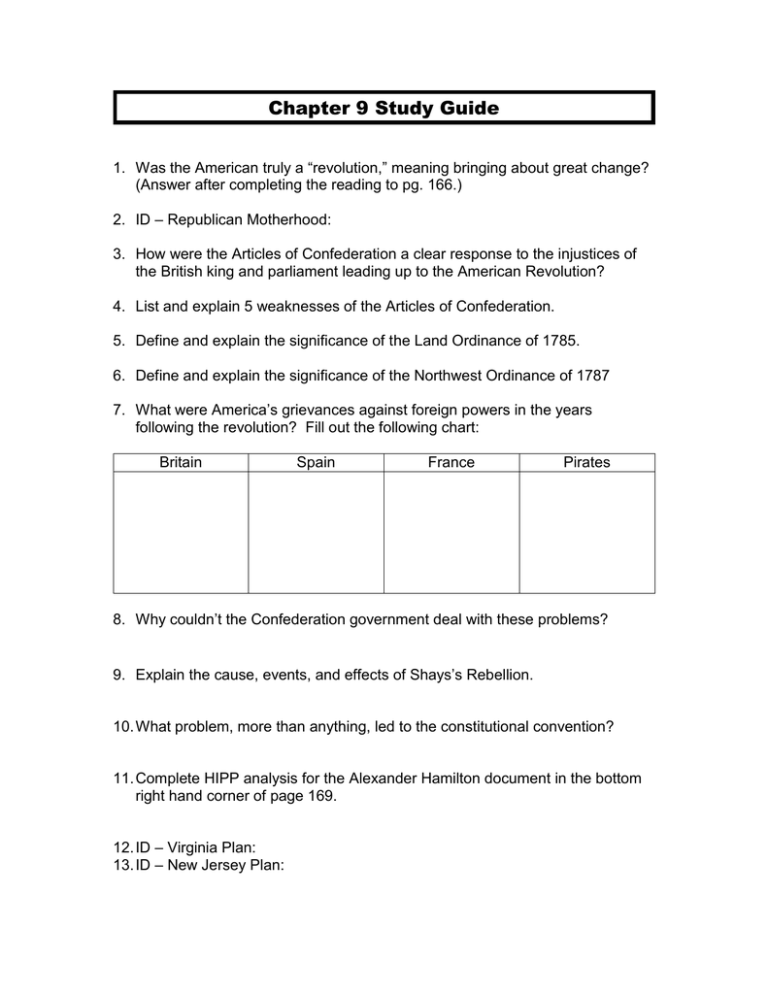
Chapter 9 Study Guide 1. Was the American truly a “revolution,” meaning bringing about great change? (Answer after completing the reading to pg. 166.) 2. ID – Republican Motherhood: 3. How were the Articles of Confederation a clear response to the injustices of the British king and parliament leading up to the American Revolution? 4. List and explain 5 weaknesses of the Articles of Confederation. 5. Define and explain the significance of the Land Ordinance of 1785. 6. Define and explain the significance of the Northwest Ordinance of 1787 7. What were America’s grievances against foreign powers in the years following the revolution? Fill out the following chart: Britain Spain France Pirates 8. Why couldn’t the Confederation government deal with these problems? 9. Explain the cause, events, and effects of Shays’s Rebellion. 10. What problem, more than anything, led to the constitutional convention? 11. Complete HIPP analysis for the Alexander Hamilton document in the bottom right hand corner of page 169. 12. ID – Virginia Plan: 13. ID – New Jersey Plan: 14. ID – Great Compromise: 15. ID – Three-fifths compromise: 16. Support, refute, or modify this statement: The members of the constitutional convention were devoted to creating the most democratic government possible. (Use information from the entire night’s reading to answer this question.) 17. How was the constitution to be ratified? 18. ID –Antifederalists (include characteristics, fears): 19. ID –Federalists (include characteristics and fears): 20. Which states lagged in ratifying the constitution and why? What did Antifederalists want? 21. ID – The Federalist: 22. Why was the ratification of the constitution a conservative triumph? Include evidence from the Varying Viewpoints portion of your reading on page 180. 23. How successful was the new nation at establishing true equality? Support your answer. Chapter 10 Study Guide 1. What precedents did George Washington set as president? 2. How did the 9th and 10th amendments assuage Antifederalist fears? 3. ID – Judiciary Act of 1789: 4. Explain Hamilton’s financial plan in bullet points: National Credit/Assumption Taxes and Tariffs National Bank 5. Explain the difference in how Hamilton and Jefferson interpreted the Constitution. How did Hamilton argue that the creation of the Bank of the US was constitutional? 6. What were the causes, events, and effects of the Whiskey Rebellion? 7. What issues and personalities led to the emergence of political parties in the US? 8. What were the similarities and differences of the American and French Revolutions? Why were their outcomes so different? Read the “Thinking Globally” section to answer this question. 9. ID – Reign of Terror: 10. What happened during the course of the French Revolution that would embroil the US in the conflict? 11. ID – Neutrality Proclamation of 1793: 12. ID – Citizen Genet: 13. ID – Treaty of Greenville: 14. What led to the drafting of Jay’s Treaty? What were the treaty’s successes and failures? How was it received by the American public and why? What was one unforeseen effect of the treaty with regards to Spain? 15. Summarize the main points of Washington’s farewell address. 16. What would later be passed to alter the way the president and vice-president were chosen? 17. What initiated problems between American and France? 18. ID – XYZ Affair: 19. Explain how did Adams put patriotism before his party. 20. ID – Convention of 1800: 21. How did fears of an external threat translate into threats to liberty at home? 22. ID - Alien and Sedition Acts: 23. What was the compact theory put forward by Jefferson and Madison and in what documents were it used? Why did these documents and the nullification doctrine they established have sweeping implications? 24. ID – Doctrine of nullification: 25. Compare Federalists and Democratic Republicans Federalists Strong or weak federal government? Conservative or liberal in their desire for increased democracy? (know if a liberal/conservative wants more or less democracy) Democratic-Republicans Regional supporters? Occupations of supporters? Favor agriculture or industry? Rule by elite or the masses? Support or oppose army/navy? British or France? Chapter 11 Study Guide 1. To what extent was the “Revolution of 1800” a revolution? Explain your answer and support it with details (using the whole section of reading for your answer.) 2. Complete the chart about Jefferson’s consistencies regarding his previously held ideals, and inconsistencies while in office (add to this chart during every night of reading from this chapter. Remind yourself of his DemocraticRepublican ideals using the chart from last night’s reading): Consistencies Inconsistencies 3. Provide TEXT, CONTEXT, SUBTEXT for this quote of Jefferson’s inaugural address: a. “We are all Republicans, we are all Federalists….Honest friendship with all nations, entangling alliances with none.” 4. ID – Judiciary Act of 1801 (include the term Midnight Judges in your definition): 5. Explain the details of the Marbury v. Madison case. Why was this ruling SO significant? 6. What inspired Jefferson to try to purchase New Orleans? Why was Napoleon willing to sell the Louisiana territory? Why did Jefferson struggle with his decision to accept Napoleon’s offer? 7. Explain the significance of the Louisiana Purchase. 8. ID – Corps of Discovery: 9. True or False – Aaron Burr is a piece of garbage. Explain your answer 10. Provide at least 3 sentences of context regarding the European wars going on before and during Jefferson’s presidency. 11. Why was the United States unable to keep itself uninvolved from these wars? 12. ID – Impressment (include and underline the ONE and only nation that impressed US sailors): 13. Describe the Chesapeake affair (including the date) and explain why it was significant. 14. How did Jefferson try to keep the nation from war? What were the reaction and effects of his action? 15. ID – Non-Intercourse Act: 16. ID – Macon’s Bill No. 2: 17. Summarize the causes of the War of 1812 in a paragraph. Include the following terms in your answer – impressment, war hawks, Tecumseh, Battle of Tippecanoe, President Madison. 18. Who supported the war? Who opposed it? Why? Chapter 12 Study Guide 1. Why was 1814 an important date in the War of 1812 with regards to British military strength and capacity? 2. ID – The Battle of New Orleans 3. ID – Treaty of Ghent: 4. What were the causes, events, and effects of the Hartford Conventions in the chart below: Causes Events Effects 5. What were the major effects of the War of 1812? 6. ID – Rush Bagot Treaty: 7. What was the significance of the Tariff of 1816 and how was it connected to the War of 1812? 8. ID – The American System: 9. Give reasons for why the “Era of Good Feelings” was an appropriate, and inappropriate name for the period. 10. Define the word speculative with regards to investment and banking (you may have to look this up online.) 11. Describe the causes of the panic of 1819, using the term “wildcat” bank in your answer. 12. Make a bullet point list of the causes of westward expansion: 13. Why did westward expansion lead to heightened sectionalism over the issue of slavery? 14. ID – Tallmadge amendment: 15. Why was the admission of Missouri into the union a threat to the unity of the nation? Why did there need to be a compromise? 16. ID – Missouri Compromise (include its significance and effectiveness): 17. ID – McCulloch v. Maryland 18. ID – loose construction: 19. ID – Cohens v. Virginia 20. ID – Gibbons v. Ogden 21. ID – Fletcher v. Peck 22. ID – Dartmouth College v. Woodward 23. Summarize general trends in John Marshal’s Supreme Court rulings. 24. ID – Adams Onis Treaty: 25. What caused Monroe to issue his Monroe Doctrine? What did it say? How significant was it during the period? Why did is have long-lasting significance?
